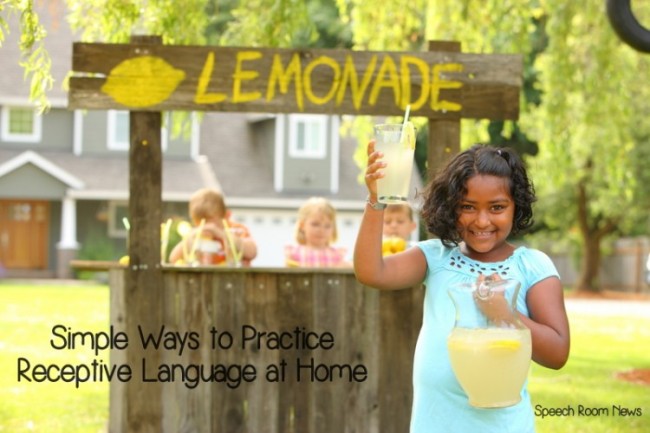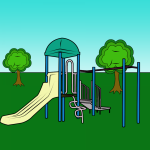As many of you know, my family and I are expecting baby number three in just a few short weeks. As I take some time off from work and blogging to spend time with my family both before and after my new son’s birth, I am thrilled to share with you some amazing posts written by some very talented bloggers. So please sit back, relax and enjoy this guest post and leave a comment letting us know what you think! Today fellow SLP Jenna from Speech Room News is here to share her ideas on building receptive language skills at home.Â
Language is often separated into two parts. Expressive language is what your child can say and express verbally. Receptive language is what your child can understand. While expressive language is sometimes to easiest to identify as delayed, delays in receptive language can have a significant impact on a child’s ability to function at home and in preschool. Children with receptive language delays struggle with skills such as understanding directions, understanding stories read to him/her, identifying vocabulary items and answering questions.

Skill: Following Directions
 Activity: Have your child set the dinner table each night. Start by giving your child one step directions with you demonstrating the task first. “Put the plates on the table.” Once your child can do one step directions with a model, remove the model and just give verbal directions. Don’t be afraid to be silly! Directions such as ” Put one napkin on your head.” will help you tell if your child is really understanding. Increase the complexity by adding two and three step directions. “Get the spoons and forks and set them in the basket.” To support your child when multiple step directions are given, match each step with one of your fingers. ‘First get the spoons and forks (showing 1 finger); Second put them in the basket (showing 2nd finger). Repeating the directions and showing visual cues like this will support your child’s ability. You can them remove those supports as your child becomes successful.
Activity: Have your child set the dinner table each night. Start by giving your child one step directions with you demonstrating the task first. “Put the plates on the table.” Once your child can do one step directions with a model, remove the model and just give verbal directions. Don’t be afraid to be silly! Directions such as ” Put one napkin on your head.” will help you tell if your child is really understanding. Increase the complexity by adding two and three step directions. “Get the spoons and forks and set them in the basket.” To support your child when multiple step directions are given, match each step with one of your fingers. ‘First get the spoons and forks (showing 1 finger); Second put them in the basket (showing 2nd finger). Repeating the directions and showing visual cues like this will support your child’s ability. You can them remove those supports as your child becomes successful.
Skill:Â Identifying Vocabulary
 Activity: Head to the local playground or park. Think about all the different vocabulary items at the park. First talk about all the things you see (sidewalk, monkey bars, slide, grass, mulch, swings, sand, trashcans, etc.) Then have a big race. Name one item in the park and let the kids race to that item. If your child is older you can play I-Spy by giving clues about one of the objects. When giving clues think about naming the function of the object (slide on it), visual description (it’s tall and red) and location clues (it’s at the top of the jungle gym). Then let your child guess the item (a slide!)
Activity: Head to the local playground or park. Think about all the different vocabulary items at the park. First talk about all the things you see (sidewalk, monkey bars, slide, grass, mulch, swings, sand, trashcans, etc.) Then have a big race. Name one item in the park and let the kids race to that item. If your child is older you can play I-Spy by giving clues about one of the objects. When giving clues think about naming the function of the object (slide on it), visual description (it’s tall and red) and location clues (it’s at the top of the jungle gym). Then let your child guess the item (a slide!)Skill:Â Sequencing
 Activity: Cooking is a great way to work on sequencing. Since it’s summer why not start up a lemonade stand with your kids? First talk about all the steps to having a lemonade stand. To start you need to make lemonade (which requires MORE sequencing!) Then you have to make signs. Lastly set up your table and sell lemonade.
Activity: Cooking is a great way to work on sequencing. Since it’s summer why not start up a lemonade stand with your kids? First talk about all the steps to having a lemonade stand. To start you need to make lemonade (which requires MORE sequencing!) Then you have to make signs. Lastly set up your table and sell lemonade.Skill:Â Answering Questions
 Activity: Head to library and pick out some NEW picture books to read. To assess your child’s ability to answer questions, you need new books that the child hasn’t memorized. This doesn’t mean you shouldn’t let your child ‘read’ Brown Bear to you for the 1000th time this week, but for this activity we need something brand new to your child. Start by taking a ‘picture walk’ through the book. Talk about WHO and WHAT you see. Point out characters and actions (“Look an owl! I think he’s singing!”) Now read the book to your child. Stop every few pages and ask a direct question about that page. WHO and WHAT questions are the first type of questions children can answer. Ask questions such as: “Who is on this page?” “What is he doing?” “What is in his mouth?” The visual supports from the story book should help your child answer. If your child can answer WHO and WHAT questions, add in WHERE and WHENÂ questions. If your child isn’t very verbal yet, story books are a wonderful way to work on receptive language. Children can point to pictures as their answer to most questions!
Activity: Head to library and pick out some NEW picture books to read. To assess your child’s ability to answer questions, you need new books that the child hasn’t memorized. This doesn’t mean you shouldn’t let your child ‘read’ Brown Bear to you for the 1000th time this week, but for this activity we need something brand new to your child. Start by taking a ‘picture walk’ through the book. Talk about WHO and WHAT you see. Point out characters and actions (“Look an owl! I think he’s singing!”) Now read the book to your child. Stop every few pages and ask a direct question about that page. WHO and WHAT questions are the first type of questions children can answer. Ask questions such as: “Who is on this page?” “What is he doing?” “What is in his mouth?” The visual supports from the story book should help your child answer. If your child can answer WHO and WHAT questions, add in WHERE and WHENÂ questions. If your child isn’t very verbal yet, story books are a wonderful way to work on receptive language. Children can point to pictures as their answer to most questions!Skill:Â Basic Concepts.
 Activity: Over, under, between, through, next to, above. These are just a few of the positional concepts  we use throughout the day. Pull out the barn set and see how many concepts your child knows. Put the farmer in the field. Put the cow under the tractor. Why is the rooster between the hay?! Take the time to engage your child an play with intention during the day.
Activity: Over, under, between, through, next to, above. These are just a few of the positional concepts  we use throughout the day. Pull out the barn set and see how many concepts your child knows. Put the farmer in the field. Put the cow under the tractor. Why is the rooster between the hay?! Take the time to engage your child an play with intention during the day.
Jenna Rayburn, MA, CCC/SLP is a Speech Language Pathologist from central Ohio. She works with children ages 2-12 through several clinics and the schools. Jenna writes the blog SpeechRoomNews where she shares easy ideas to make speech therapy fun!Â
[…] Language is often separated into two parts. Expressive language is what your child can say and express verbally. Receptive language is what your child can understand. While expressive language is sometimes to easiest to identify as delayed, delays in receptive language can have a significant impact on a child’s ability to function at home and in preschool. Children with receptive language delays struggle with skills such as understanding directions, understanding stories read to him/her, identifying vocabulary items and answering questions. Today I want to share with you some quick and easy ways to support your child’s receptive language at home. It’s quite easy once you think about a specific skill. The key is to pick one skill and have intention to target it throughout your day. Head on over to Katie’s blog to check out the rest of the content! […]